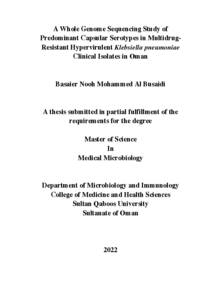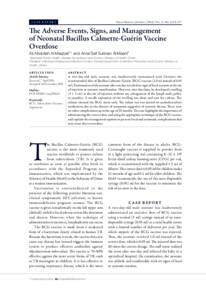Document
A Whole genome sequencing study of predominant capsular serotypes in multidrug resistant hypervirulent klebsiella pneumoniae clinical isolates in Oman.
Other titles
دراسة تسلسل الجينوم الكامل للأنماط المصلية السائدة في العزلات السريرية شديدة الضراوة لبكتيريا الكلبسيلا الرئوية المقاومة للأدوية المتعددة في سلطنة عمان
Publisher
Sultan Qaboos University.
Gregorian
2022
Language
English
Subject
English abstract
Background: Hypervirulent Klebsiella pneumoniae has been associated with severe
fatal infections in humans as well as the decrease in the effectiveness of treatment
options due to their high level of virulence and antimicrobial resistance patterns. The
aim of this study is to screen for prevalent hypervirulent capsular serotypes in Oman
and investigate their virulence and resistance profiles using whole genome sequencing
(WGS).
Methods: A total of 129 K. pneumoniae isolates from Sultan Qaboos University
Hospital (SQUH) and CPHL from 2015-2021 were screened by conventional PCR for
capsular serotypes K1, K2, K20, K54 and K57. The hypervirulent isolates were sent
for WGS and analysed using various bioinformatic tools including determining the
sequence type, acquired resistance genes, existent plasmids, k-loci genetic
arrangement and their phylogenetic evolutionary relationships. Antimicrobial
susceptibility test was performed using disk diffusion phenotypic method following
Clinical and Laboratory Standards Institute (CSLI) and the results were compared with
the WGS findings. Moreover, virulence assay using the larvae of Galleria mellonela
and serum resistance bactericidal assays were performed.
Results: Hypervirulent capsular serotypes were detected in 3% (4/129) of the K.
pneumoniae isolates belonging to either K1 or K2. WGS revealed the presence of a
wide variety of antibiotic resistance genes carried by various plasmids. Moreover, the
isolates that have a similar sequence type also have a similar k-loci genetic
arrangement and are present next to each other in the phylogenetic tree which suggests
likelihood of transmission. Virulence assay showed that K1-positive hypervirulent
serotype is as virulent as K2 however, non-hypervirulent serotypes are less virulent.
Finally, the human serum assay revealed the ability of the hypervirulent isolates to
resist serum bactericidal activity including complement and antibody mediated
neutralisation.
Conclusions: The project highlighted the importance of screening for hypervirulent
capsular serotypes as they are associated with increased resistance and virulence
patterns despite their low prevalence in Oman in the time being. Moreover, the results
emphasise on the importance of the implementation of control and prevention
strategies in preparation for future outbreaks.
Member of
Resource URL
Category
Theses and Dissertations


